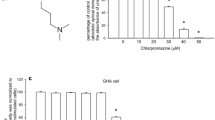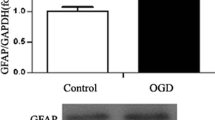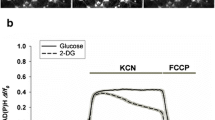Abstract
Brain hypoxia or ischemia causes acidosis and the intracellular accumulation of Ca2+ in neuron. The aims of the present study were to elucidate the interaction between intracellular pH and Ca2+ during transient acidosis and its effects on the viability of neuronal and glial cells. Intracellular Ca2+ and pH were measured using the fluorescence of fura-2 and 2′,7′-bis(2-carboxyethyl)-5(6)-carboxyfluorescein acetoxymethyl ester in neuroblastoma (IMR-32), glioblastoma (T98G), and astrocytoma (CCF-STTG1) cell lines. The administration of 5 mM propionate caused intracellular acidification in IMR-32 and T98G cells but not in CCF-STTG1 cells. After the removal of propionate, the intracellular pH recovered to the resting level. The intracellular Ca2+ transiently increased upon the removal of propionate in IMR-32 and T98G cells but not in CCF-STTG1 cells. The transient Ca2+ increase caused by the withdrawal of intracellular acidification was abolished by the removal of external Ca2+, diminished by a reduction of external Na+, and inhibited by benzamil. Transient acidosis caused cell death, whereas the cells were more viable in the absence of external Ca2+. Benzamil alleviated cell death caused by transient acidosis in IMR-32 and T98G cells but not in CCF-STTG1 cells. These results suggest that recovery from intracellular acidosis causes a transient increase in cytosolic Ca2+ due to reversal of Ca2+ transport via Na+/Ca2+ exchanger coactivated with Na+/H+ exchanger, which can cause cell death.





Similar content being viewed by others
References
Aarts M, Iihara K, Wei WL, Xiong ZG, Arundine M, Cerwinski W, MacDonald JF, Tymianski M (2003) A key role for TRPM7 channels in anoxic neuronal death. Cell 115:863–877
Annunziato L, Pignataro G, Di Renzo GF (2004) Pharmacology of brain Na+/Ca2+ exchanger: from molecular biology to therapeutic perspectives. Pharmacol Rev 56:633–654
Bano D, Young KW, Guerin CJ, Lefeuvre R, Rothwell NJ, Naldini L, Rizzuto R, Carafoli E, Nicotera P (2005) Cleavage of the plasma membrane Na+/Ca2+ exchanger in excitotoxicity. Cell 120:275–285
Chesler M (2003) Regulation and modulation of pH in the brain. Physiol Rev 83:1183–1221
Chesler M (2005) Failure and function of intracellular pH regulation in acute hypoxic-ischemic injury of astrocytes. Glia 50:398–406
DiPolo R, Beauge L (2006) Sodium/calcium exchanger: influence of metabolic regulation on ion carrier interactions. Physiol Rev 86:155–203
Duchen MR (2000) Mitochondria and calcium: from cell signalling to cell death. J Physiol 529:57–68
Hague A, Elder DJ, Hicks DJ, Paraskeva C (1995) Apoptosis in colorectal tumour cells: induction by the short chain fatty acids butyrate, propionate and acetate and by the bile salt deoxycholate. Int J Cancer 60:400–406
Holzer P (2003) Acid-sensitive ion channels in gastrointestinal function. Curr Opin Pharmacol 3:618–625
Jan G, Belzacq AS, Haouzi D, Rouault A, Metivier D, Kroemer G, Brenner C (2002) Propionibacteria induce apoptosis of colorectal carcinoma cells via short-chain fatty acids acting on mitochondria. Cell Death Differ 9:179–188
Kitazono T, Takeshige K, Cragoe EJ Jr, Minakami S (1989) Involvement of calcium and protein kinase C in the activation of the Na+/H+ exchanger in cultured bovine aortic endothelial cells stimulated by extracellular ATP. Biochim Biophys Acta 1013:152–158
Kristian T (2004) Metabolic stages, mitochondria and calcium in hypoxic/ischemic brain damage. Cell Calcium 36:221–233
Lipton P (1999) Ischemic cell death in brain neurons. Physiol Rev 79:1431–1568
Luo J, Chen H, Kintner DB, Shull GE, Sun D (2005) Decreased neuronal death in Na+/H+ exchanger isoform 1-null mice after in vitro and in vivo ischemia. J Neurosci 25:11256–11268
Matsumoto Y, Yamamoto S, Suzuki Y, Tsuboi T, Terakawa S, Ohashi N, Umemura K (2004) Na+/H+ exchanger inhibitor, SM-20220, is protective against excitotoxicity in cultured cortical neurons. Stroke 35:185–190
Matthews GM, Howarth GS, Butler RN (2007) Short-chain fatty acid modulation of apoptosis in the Kato III human gastric carcinoma cell line. Cancer Biol Ther 6:1051–1057
Orlowski J, Grinstein S (2004) Diversity of the mammalian sodium/proton exchanger SLC9 gene family. Pflugers Arch 447:549–565
Quednau BD, Nicoll DA, Philipson KD (2004) The sodium/calcium exchanger family—SLC8. Pflugers Arch 447:543–548
Thomas JA, Buchsbaum RN, Zimniak A, Racker E (1979) Intracellular pH measurements in Ehrlich ascites tumor cells utilizing spectroscopic probes generated in situ. Biochemistry 18:2210–2218
Verkhratsky A (2005) Physiology and pathophysiology of the calcium store in the endoplasmic reticulum of neurons. Physiol Rev 85:201–279
Vornov JJ, Thomas AG, Jo D (1996) Protective effects of extracellular acidosis and blockade of sodium/hydrogen ion exchange during recovery from metabolic inhibition in neuronal tissue culture. J Neurochem 67:2379–2389
Wang WZ, Chu XP, Li MH, Seeds J, Simon RP, Xiong ZG (2006) Modulation of acid-sensing ion channel currents, acid-induced increase of intracellular Ca2+, and acidosis-mediated neuronal injury by intracellular pH. J Biol Chem 281:29369–29378
Xiong ZG, Zhu XM, Chu XP, Minami M, Hey J, Wei WL, MacDonald JF, Wemmie JA, Price MP, Welsh MJ, Simon RP (2004) Neuroprotection in ischemia: blocking calcium-permeable acid-sensing ion channels. Cell 118:687–698
Yao H, Haddad GG (2004) Calcium and pH homeostasis in neurons during hypoxia and ischemia. Cell Calcium 36:247–255
Yermolaieva O, Leonard AS, Schnizler MK, Abboud FM, Welsh MJ (2004) Extracellular acidosis increases neuronal cell calcium by activating acid-sensing ion channel 1a. Proc Natl Acad Sci USA 101:6752–6757
Acknowledgments
This work was supported by a Grand-in-Aid for Scientific Research from the Japanese Ministry of Education, Culture, Sports, Science and Technology (C 19590992). We are grateful to the Cell Resource Center for Biomedical Research, Tohoku University for donating the cell lines.
Author information
Authors and Affiliations
Corresponding author
Rights and permissions
About this article
Cite this article
Shono, Y., Kamouchi, M., Kitazono, T. et al. Change in Intracellular pH Causes the Toxic Ca2+ Entry via NCX1 in Neuron- and Glia-Derived Cells. Cell Mol Neurobiol 30, 453–460 (2010). https://doi.org/10.1007/s10571-009-9470-7
Received:
Accepted:
Published:
Issue Date:
DOI: https://doi.org/10.1007/s10571-009-9470-7




